RickI
Contributor
I recently had the pleasure to learn of IRME, a film project based in Bodrum, Turkey through its creator, Mert Gokalp. The short film deals with sponge diving and the passage of this way of life into the past as a result of the sponge blight. The impacts of the sponge blight have been significant in this coastal fishing town and many other similar towns throughout the Aegean Sea.

The film conveys messages on several levels. The primary conflict is between a boy longing to dive and work in the sea, his father a sponge boat captain who wants him to stay on land and the boy's mentor, a renowned sponge diver, now crippled for life after a bad case of the bends. On other levels the film treats the fading into the past of this fishing town to be replaced with a tourist destination rife with resorts and night clubs. Finally it offers some insights on new ecological imperatives likely brought on by climate change likely an important cause of the sponge blight and poor resource husbandry practices. Mert wanted to show the Bodrum of the past along with the dramatic stories of divers, with so many lost and injured working the sea. Production photos are from the film's Facebook page at https://www.facebook.com/pages/IRME/1477722369146756
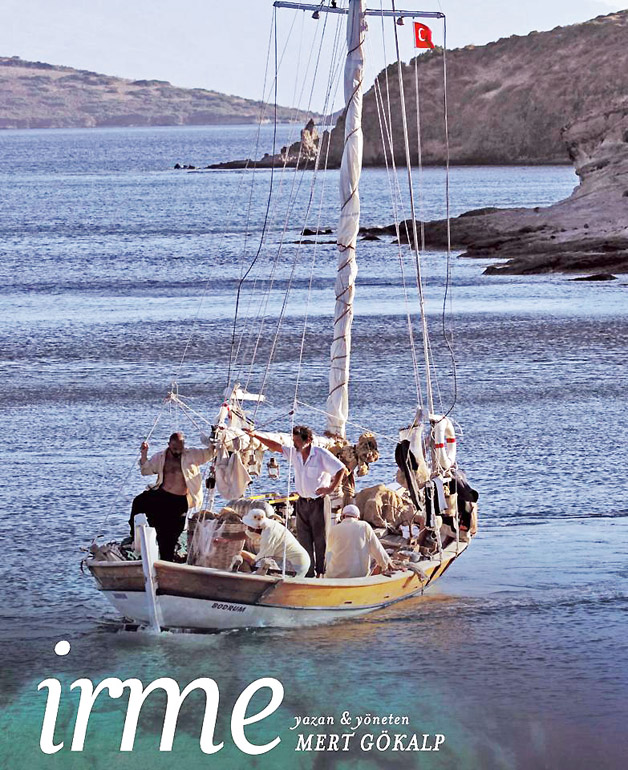
IRME's setting involves a boat and its working crew in the middle of the Mediterranean sea in the 1970s on the brink of the collapse of the sponge fishery with a blight wiping out stocks. The sponge blight substantially reduces the quantity, quality of the sponges, reducing size and changing them to a brittle texture ruining the commercial and practical value. The father also a sponge captain, never wanted his boy to work on the sea for many reasons. The trials, high risk of injury and death including some family and friends in the past, makes him want his son to take up farming on land instead. The boy finds work in another boat driven by his longing for the sea. The boy learns diving from the cripple Omer, a famous diver working on that boat who suffered paralysis from the bends. Time passes and the cripple and the boy end up working on the father's boat. There is an acute sponge shortage with dive after dive resulting in no sponges being found. The crew is upset with building frustration with no prospect in sight but to continue searching. The mounting tension among the captain/father, the boy and the cripple, conveys the viewer into the desolation of the broad sea, barren bottom with the harsh realities of the changing times.
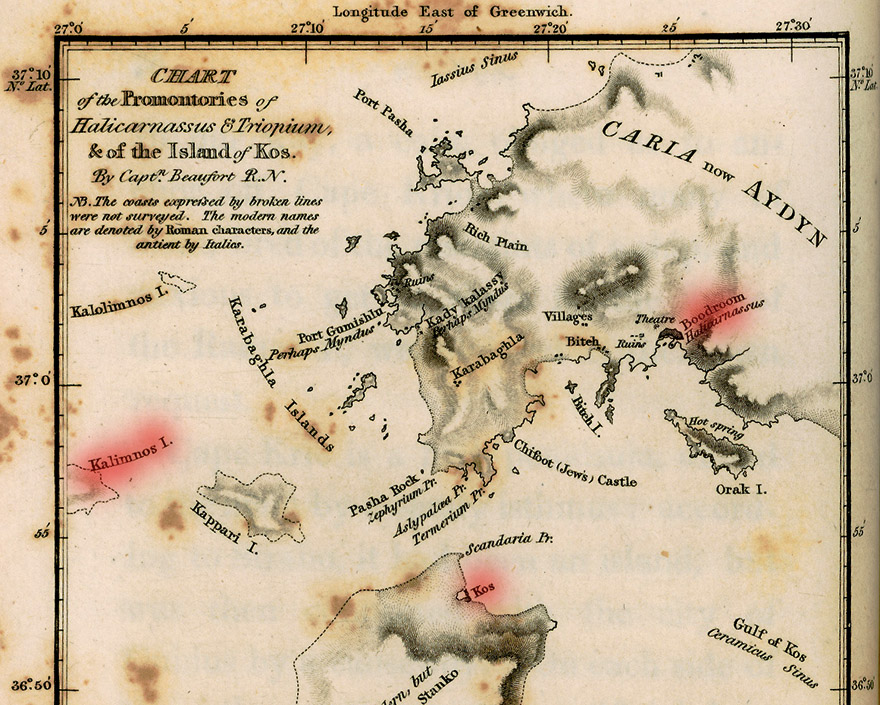
Part of an 1817 chart showing the southeastern Aegean Sea containing Bodrum, Turkey to the east, the focus on this film. Also the Greeks islands of Kos to the south and Kalminos, center of sponge commerce to the west are highlighted on the chart. Kalminos was the commercial center of the sponge industry for the region. Sponges recovered by the Bodrum fleet were ultimately sold in Kalminos which exercised considerable influence on the area. There were a lot of similarities between Greek and Turkish sponge diving operations. In large measure they shared fishing areas, technology, even divers at times and maintained friendships.
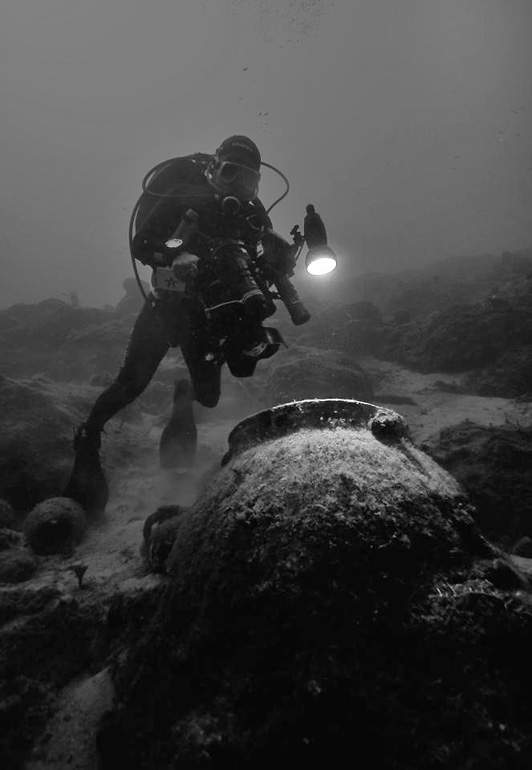
Mert Gokalp is the director, script writer and underwater DOP for the film. He is a marine scientist, photographer/videographer and documentary maker born in Ankara, 1978. He did graduate work at South Florida's own RSMAS institution in Miami. He is currently working on his PHD through the University Of Wageningen. He worked as a marine biologist in 6th & 7th frame European Union projects. He produced 4 individual photography exhibitions along with a guidebook for Turkish Marine Species & a smartphone application for Mediterranean marine species called Doga Rehberi. He has been working as a freelancer since 2006 involved in nature documentaries as an underwater camera operator; Labyrinth-VPRO, Sponges & Corals episodes - HET KLOKHUIS - NTR, Caretta caretta - IZTV. Currently working on 2 underwater documentaries and an underwater photography project. Mert is shown above loaded for bear with underwater tech, shooting amphora on a wreck off Kas, Turkey.
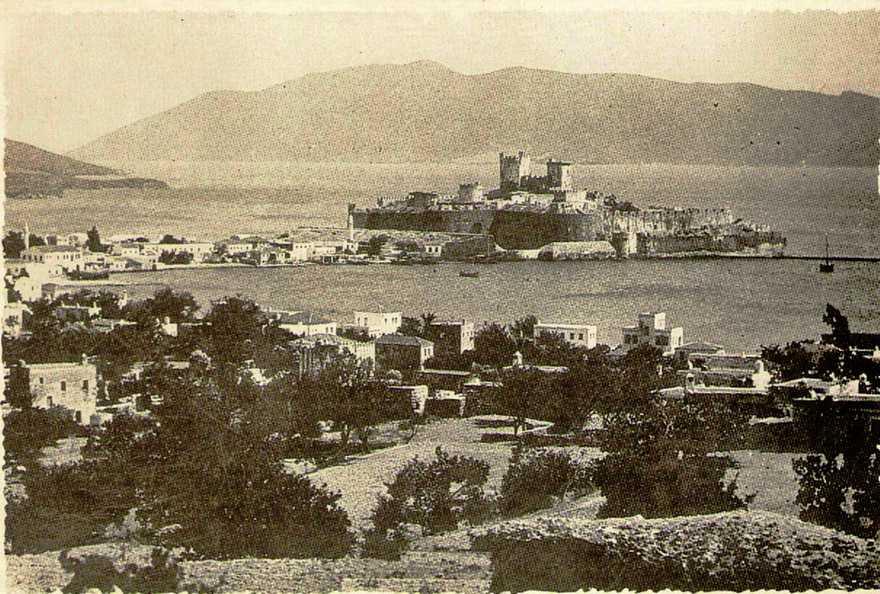
A look over Bodrum towards the Bodrum Kalesi or castle from the 1950's. The castle construction was started in 1402 by the Knights Hospitaller as a secondary stronghold to their castle on nearby Rhodes. Today the castle contains the unique Museum of Underwater Archaeology created by the Turkish government in the early 1960's to house the numerous undersea finds from the Aegean. Many of these discoveries were made by sponge divers. There are exhibits dealing sponge diving in this museum.
From: Xanthos Yachting
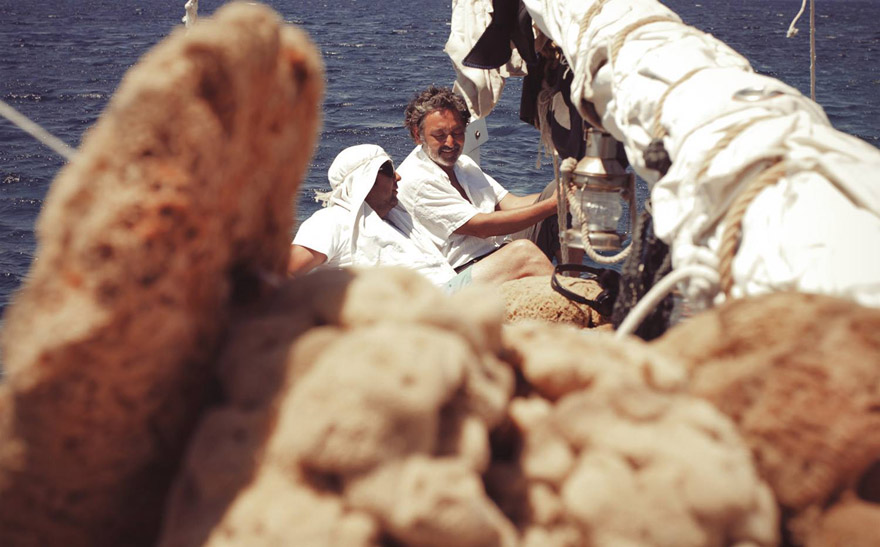
Through time, sponge diving has been a source of great wealth, shifting of population centers, creation of lifestyles through generations, development of new diving technologies, crippling debt at times, as well as painful injury, disability and death. The conflict between seeking profit, human limitations and diving physics has long taken a toll in this fishery.
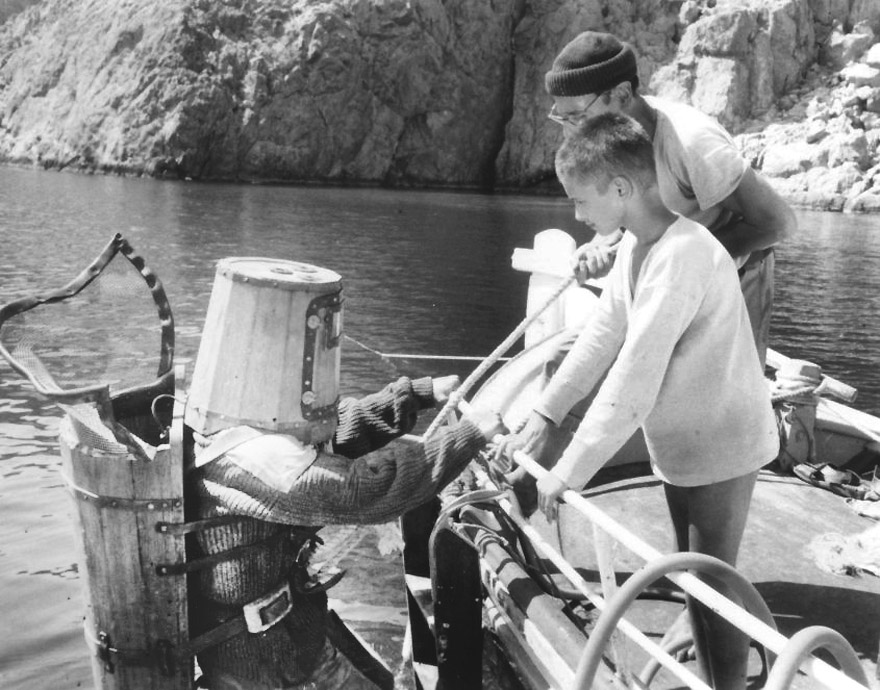
In a number of ways the film reminds me of aspects of Luc Besson's "The Big Blue," originally "Le grand bleu" of 1988. The film has become a cult classic among free divers everywhere and is a personal favorite as well. To see another work, even a short film delving in this area is of strong personal interest hence my writing this overview. Above is the scene involving Jacques Mayol's father employing particularly primitive surface supply diving technology. From: The Big Blue (1988) - IMDb
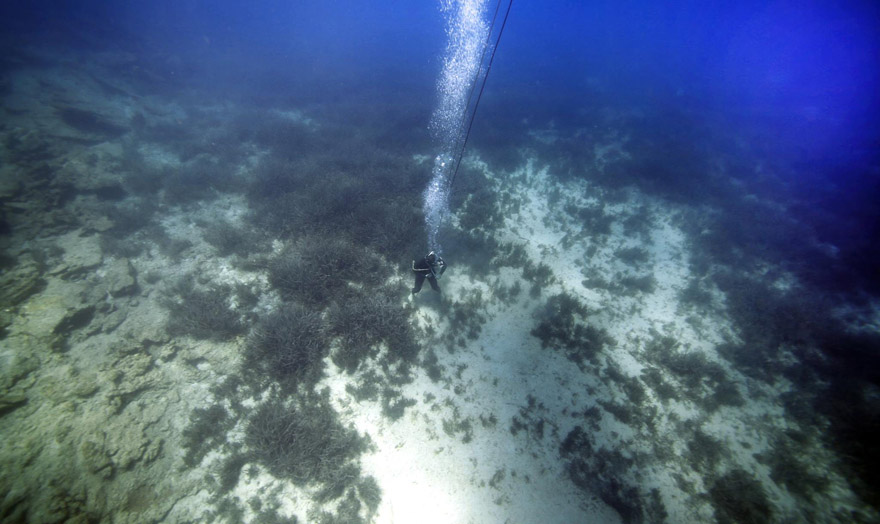
Mert is at depth preparing for the shooting of a scene. He told me that historically sponge dives were made down to 80 to 90 m (260 to 290 ft.). There were two classes of divers, those diving the more heavily harvested shallow areas for lower quality, few sponges and those working the deeper zones with better sponges and greater risk of DCS (dekompresyon hastalığı and other barotrauma (barotravmadır). There were three to four divers per boat depending on the size of the vessel. The dives were relative short with 15 to 30 minute bottom times but with poor decompression practice, too rapid ascent, no or inadequate stage decompression, they were set up for problems. Inadequate decompression brought on by too rapid ascent can cause nitrogen bubbles to form in the diver's body which can cause blockages in blood vessels, joints and pinch nerves resulting in pain and paralysis. The symptoms of decompression sickness or DCS are largely dependent upon where the bubbles occur and interfere with function. The bends arise from bubbles in joint areas and from pinching nerves. Other types of DCS can develop from bubble blockages in the brain, heart and other nerve areas such as related to vision. There are still other types of barotrauma or pressure related disease which impacted the divers such as nitrogen narcosis (azot narkozu), impairing judgement, oxygen toxicity (oksijen zehirlenmesi) related seizures and diminished function, aero embolism (aero emboli), prompted by excessive speed of ascent, long term bone joint degeneration through Dysbaric osteonecrosis (Dysbaric osteonekroz) and still more. There were no hyperbaric treatment centers with recompression chambers or likely even well informed and equipped medical care. The divers were largely on their own to try to avoid and deal with the consequences of barotrauma. There is a famous sponge diver in Bodrum, Aksona Mehmet who was an active scaphandro diver and carries the nick name "the last sponge diver." Aksona has been diving for over 50 years and is one of the few divers who continue to recover sponges. His nickname "Aksona" was taken from his sailboat but also is the name that deals with diver decompression. The term aksona didn't imply the use of decompression tables necessarily but more rules of thumb based upon accumulated knowledge and experience. As such, aksona may not have been accurate particularly with deeper and/or more extreme exposures.
and other barotrauma (barotravmadır). There were three to four divers per boat depending on the size of the vessel. The dives were relative short with 15 to 30 minute bottom times but with poor decompression practice, too rapid ascent, no or inadequate stage decompression, they were set up for problems. Inadequate decompression brought on by too rapid ascent can cause nitrogen bubbles to form in the diver's body which can cause blockages in blood vessels, joints and pinch nerves resulting in pain and paralysis. The symptoms of decompression sickness or DCS are largely dependent upon where the bubbles occur and interfere with function. The bends arise from bubbles in joint areas and from pinching nerves. Other types of DCS can develop from bubble blockages in the brain, heart and other nerve areas such as related to vision. There are still other types of barotrauma or pressure related disease which impacted the divers such as nitrogen narcosis (azot narkozu), impairing judgement, oxygen toxicity (oksijen zehirlenmesi) related seizures and diminished function, aero embolism (aero emboli), prompted by excessive speed of ascent, long term bone joint degeneration through Dysbaric osteonecrosis (Dysbaric osteonekroz) and still more. There were no hyperbaric treatment centers with recompression chambers or likely even well informed and equipped medical care. The divers were largely on their own to try to avoid and deal with the consequences of barotrauma. There is a famous sponge diver in Bodrum, Aksona Mehmet who was an active scaphandro diver and carries the nick name "the last sponge diver." Aksona has been diving for over 50 years and is one of the few divers who continue to recover sponges. His nickname "Aksona" was taken from his sailboat but also is the name that deals with diver decompression. The term aksona didn't imply the use of decompression tables necessarily but more rules of thumb based upon accumulated knowledge and experience. As such, aksona may not have been accurate particularly with deeper and/or more extreme exposures.
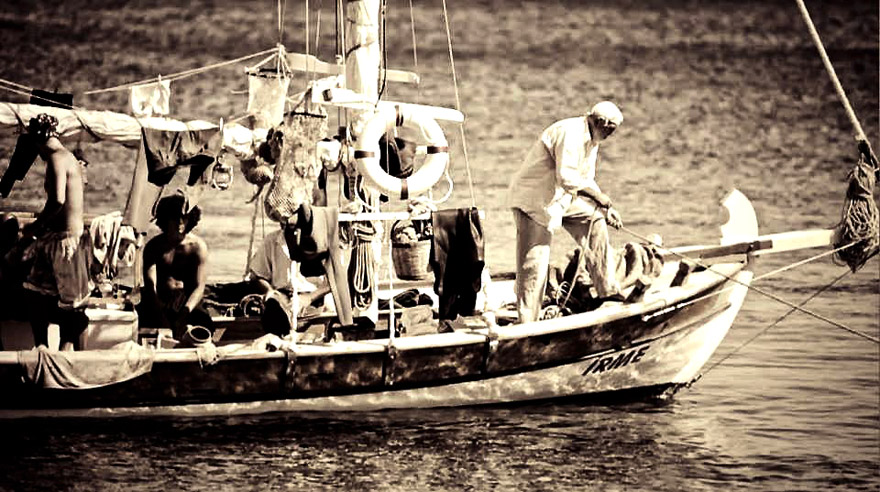
Prevention of DCS is an involved process but at the basic level requires use of decompression tables or computers that prescribe decompression stops for specific durations and certain depths to allow the safe "off gassing" of nitrogen. Such tables were brought to Bodrum in the 1960's I understand from Mert by two men who taught scuba diving. More divers started to use scuba gear instead of hookah rigs and accidents diminished somewhat. For most of the time though no deco tables were used only experience and if what I have encountered in other parts of the world holds, some degree of superstition. I met a commercial spear fisherman in the Bahamas who doesn't use deco tables or dive computers now that they are available but relies upon a "feeling" reinforced by long experience. He has been hit or suffered the bends a number of times which unfortunately can be cumulative with the same areas being impacted over and over again. He never contemplated recompression in a chamber which is the best way of treating DCS but did swear by the benefits of Bayer aspirin, "use no other." In-water recompression is sometimes pursued but can be problematical particularly in the absence of proven procedures and diver health. I once knew a scientific diver when I was a kid in the early 1970's who used to say, "decompression tables, bah, it is something you feel in here" as he beat his chest. I think he was recompressed nine times before they banned him at the chamber. Human nature can be a hard thing to overcome in short and can carry a high price in trials and pain but so it goes.
Continued with more photos, information and the film trailer at: IRME, A Short Film - The Passing Of Sponge Diving In Turkey - FKA Kiteboarding Forums

The film conveys messages on several levels. The primary conflict is between a boy longing to dive and work in the sea, his father a sponge boat captain who wants him to stay on land and the boy's mentor, a renowned sponge diver, now crippled for life after a bad case of the bends. On other levels the film treats the fading into the past of this fishing town to be replaced with a tourist destination rife with resorts and night clubs. Finally it offers some insights on new ecological imperatives likely brought on by climate change likely an important cause of the sponge blight and poor resource husbandry practices. Mert wanted to show the Bodrum of the past along with the dramatic stories of divers, with so many lost and injured working the sea. Production photos are from the film's Facebook page at https://www.facebook.com/pages/IRME/1477722369146756

IRME's setting involves a boat and its working crew in the middle of the Mediterranean sea in the 1970s on the brink of the collapse of the sponge fishery with a blight wiping out stocks. The sponge blight substantially reduces the quantity, quality of the sponges, reducing size and changing them to a brittle texture ruining the commercial and practical value. The father also a sponge captain, never wanted his boy to work on the sea for many reasons. The trials, high risk of injury and death including some family and friends in the past, makes him want his son to take up farming on land instead. The boy finds work in another boat driven by his longing for the sea. The boy learns diving from the cripple Omer, a famous diver working on that boat who suffered paralysis from the bends. Time passes and the cripple and the boy end up working on the father's boat. There is an acute sponge shortage with dive after dive resulting in no sponges being found. The crew is upset with building frustration with no prospect in sight but to continue searching. The mounting tension among the captain/father, the boy and the cripple, conveys the viewer into the desolation of the broad sea, barren bottom with the harsh realities of the changing times.

Part of an 1817 chart showing the southeastern Aegean Sea containing Bodrum, Turkey to the east, the focus on this film. Also the Greeks islands of Kos to the south and Kalminos, center of sponge commerce to the west are highlighted on the chart. Kalminos was the commercial center of the sponge industry for the region. Sponges recovered by the Bodrum fleet were ultimately sold in Kalminos which exercised considerable influence on the area. There were a lot of similarities between Greek and Turkish sponge diving operations. In large measure they shared fishing areas, technology, even divers at times and maintained friendships.

Mert Gokalp is the director, script writer and underwater DOP for the film. He is a marine scientist, photographer/videographer and documentary maker born in Ankara, 1978. He did graduate work at South Florida's own RSMAS institution in Miami. He is currently working on his PHD through the University Of Wageningen. He worked as a marine biologist in 6th & 7th frame European Union projects. He produced 4 individual photography exhibitions along with a guidebook for Turkish Marine Species & a smartphone application for Mediterranean marine species called Doga Rehberi. He has been working as a freelancer since 2006 involved in nature documentaries as an underwater camera operator; Labyrinth-VPRO, Sponges & Corals episodes - HET KLOKHUIS - NTR, Caretta caretta - IZTV. Currently working on 2 underwater documentaries and an underwater photography project. Mert is shown above loaded for bear with underwater tech, shooting amphora on a wreck off Kas, Turkey.

A look over Bodrum towards the Bodrum Kalesi or castle from the 1950's. The castle construction was started in 1402 by the Knights Hospitaller as a secondary stronghold to their castle on nearby Rhodes. Today the castle contains the unique Museum of Underwater Archaeology created by the Turkish government in the early 1960's to house the numerous undersea finds from the Aegean. Many of these discoveries were made by sponge divers. There are exhibits dealing sponge diving in this museum.
From: Xanthos Yachting

Through time, sponge diving has been a source of great wealth, shifting of population centers, creation of lifestyles through generations, development of new diving technologies, crippling debt at times, as well as painful injury, disability and death. The conflict between seeking profit, human limitations and diving physics has long taken a toll in this fishery.

In a number of ways the film reminds me of aspects of Luc Besson's "The Big Blue," originally "Le grand bleu" of 1988. The film has become a cult classic among free divers everywhere and is a personal favorite as well. To see another work, even a short film delving in this area is of strong personal interest hence my writing this overview. Above is the scene involving Jacques Mayol's father employing particularly primitive surface supply diving technology. From: The Big Blue (1988) - IMDb

Mert is at depth preparing for the shooting of a scene. He told me that historically sponge dives were made down to 80 to 90 m (260 to 290 ft.). There were two classes of divers, those diving the more heavily harvested shallow areas for lower quality, few sponges and those working the deeper zones with better sponges and greater risk of DCS (dekompresyon hastalığı

Prevention of DCS is an involved process but at the basic level requires use of decompression tables or computers that prescribe decompression stops for specific durations and certain depths to allow the safe "off gassing" of nitrogen. Such tables were brought to Bodrum in the 1960's I understand from Mert by two men who taught scuba diving. More divers started to use scuba gear instead of hookah rigs and accidents diminished somewhat. For most of the time though no deco tables were used only experience and if what I have encountered in other parts of the world holds, some degree of superstition. I met a commercial spear fisherman in the Bahamas who doesn't use deco tables or dive computers now that they are available but relies upon a "feeling" reinforced by long experience. He has been hit or suffered the bends a number of times which unfortunately can be cumulative with the same areas being impacted over and over again. He never contemplated recompression in a chamber which is the best way of treating DCS but did swear by the benefits of Bayer aspirin, "use no other." In-water recompression is sometimes pursued but can be problematical particularly in the absence of proven procedures and diver health. I once knew a scientific diver when I was a kid in the early 1970's who used to say, "decompression tables, bah, it is something you feel in here" as he beat his chest. I think he was recompressed nine times before they banned him at the chamber. Human nature can be a hard thing to overcome in short and can carry a high price in trials and pain but so it goes.
Continued with more photos, information and the film trailer at: IRME, A Short Film - The Passing Of Sponge Diving In Turkey - FKA Kiteboarding Forums





